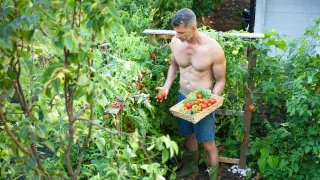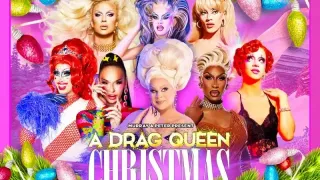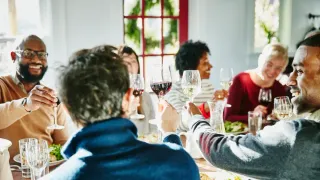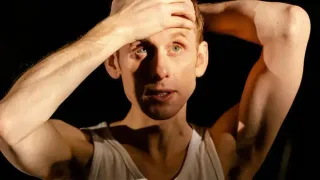July 20, 2022
D. L. Forbes and 'The Unique Individual'
Charles Steiner READ TIME: 5 MIN.
A painter in San Francisco for more than 42 years, D.L. Forbes was first interviewed by the Bay Area Reporter for his five-year retrospective in September 1980 at age 29.
He is now fast becoming known as a novelist and poet with seven volumes of poetry, three novels, and a memoir in print. The charming and very readable memoir, "Wittgenstein's Son and U. G. Krishnamurti: Ducks or Rabbits" is a deserved subject for discussion as it sums up the author's life, fully and un-ordinarily, in San Francisco while focusing on two major influences: Ludwig Wittgenstein, the Austrian-British philosopher whose work was a staple in colleges during the 1960s because of his deep questioning of language and its meaning; and U.G. Krishnamurti, who was an anti-guru deeply questioning and dismantling the state of spiritual enlightenment.
The author at age 12 learned that Wittgenstein was in fact his biological father, according to his own mother, and the father figure in U.G was for some time the emotional and psychological substitute for his real but unavailable father.
Charles Steiner: Though you compared and contrasted Wittgenstein and Krishnamurti throughout your memoir, at the end of it, you completely distrusted their claims of certainty. Have I read you right?
D.L. Forbes: After years of attempting to understand my father's work and the many interactions I had with U.G. Krishnamurti, I found that the complete certainty they professed in their 'non-philosophies' were not only near impossible to grasp, but generally not of much use to me, and perhaps not to anyone, and for the simple reason, that one was not them.
I know that Ludwig Wittgenstein never married and was gay, but I'm not sure many know that he was. What would you say to someone who can't understand that he fathered a son and yet was gay?
Well, you only have to consider the lives of many prominent gay people in history who fathered children; Oscar Wilde, Andre Gide, W. Somerset Maugham.
Although your father died three days after you were born, you met with U.G. Krishnamurti countless times in the 1980s, and he found you intriguing enough to label you a "unique person." Was it your being gay that brought out that remark?
Partly, and partly because of my interest in therapeutic and sexual prostate massage which I pursued part-time for many years, and told U.G. about, and oddly perhaps, with his encouragement. I seemed to be in and out of the B.A.R. office endlessly then, either placing ads for life-enhancing massage or obituaries for loved ones.
People may think from the title of your book that it's academic and very serious, but it's really aimed at gay people in general whose lives are challenging and not stereotypical in the least, and there's lots of other well-known personalities brought into your memoir, in particular, Margaret Cho, who actually talked about you in her own memoir, "I'm the One I Want."
I met Margaret in 1980 when she was twelve years old. I was working at her father's bookstore, Paperback Traffic, on the corner of Polk and California. Almost immediately I became her unofficial English nanny for a decade, and actually up until this moment. She's a lovely person.
In her first memoir, Margaret Cho mentions you having an elbow-to-ass tattoo on your back. Is that true?
Yes. I did the design, and Ed Hardy executed it; and proudly I took Margaret to meet Ed for her very first tattoo, as any really caring nanny would.
The description of your visit with your boyfriend to see Christopher Isherwood and Don Bachardy makes for riveting reading, particularly for anyone who has ever been in a relationship and witnessed covetousness in action. Can you say more about that episode?
Well, let's just say that in the end the visit turned out to be passionately gratifying.
Your memoir makes for attention-grabbing reading in that it's not a chronological narrative you tell. It spans from 1973 through 2020, but your method of selection from your journals really makes your work very appealing. Can you give us a glimpse of how you employed your method?
That was the complicated part of creating the book, the narrative arc I wanted it to possess. I had to chop out a lot of repetitive journal entries and leave out certain names and events in order to give the work an overall integrity that was consistent and without contradictions.
In addition to your memoir and novels, you've written books of poetry. I admire your love poems from "Rough Fluff," particularly those featuring the policeman. Do you give poetry readings as well?
Thanks. I'm glad you liked them. Yes, I do give poetry readings. I did a feature read recently with the social activist and poet Sarah Menefee. You can see the last poetry reading on YouTube:
I'm familiar with several of your paintings, and I know you've had exhibitions not only in San Francisco but also in Santa Monica. It looks like a lot of the cover art for your books is your own artwork. Am I right?
I've had several shows in Santa Monica; two with Ed Hardy. And yes, I use my paintings and photographs for my book covers.
Your published work can be found on Amazon and at Apple Books. Are there any other venues where your memoir and other writings can be found?
Yes, they're all over the place. The memoir and seven other books can also be found at San Francisco Public Library on e-books. And three plays soon to be published.
You're prolific.
Well, not so prolific if you consider it took four decades plus to hash them out. Anyhow, hopefully readers may find something worthwhile in these alleged page-turners.
Help keep the Bay Area Reporter going in these tough times. To support local, independent, LGBTQ journalism, consider becoming a BAR member.






